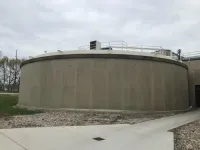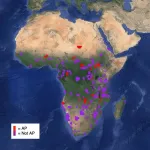(Press-News.org)
AMES, Iowa – Strategically planting perennial grass throughout corn and soybean fields helps address the unintended environmental consequences of growing the dominant row crops, including soil erosion, fertilizer runoff and greenhouse gas emissions.
But converting portions of farmland back to prairie has to make financial sense for farmers, which is why a research team led by Iowa State University landscape ecologist Lisa Schulte Moore has spent the past six years studying how to efficiently turn harvested grass into lucrative renewable natural gas.
“We’re looking at existing markets where there is already a demand, use existing infrastructure to reduce costs of the energy transition and create wins in multiple categories. We want wins for farmers, wins for businesses, wins for municipalities and wins for society,” said Schulte Moore, professor of natural resource ecology and management and director of the Consortium for Cultivating Human And Naturally reGenerative Enterprises (C-CHANGE). “We can have great conversations about what could be, but unless it benefits everyone along these supply chains, it won’t happen.”
A pair of recently published peer-reviewed articles by Schulte-Moore’s research group modeled the economic feasibility of grass-to-gas production in different settings and from varying perspectives, analysis that helps flesh out the system’s win-win potential.
“To replace natural gas with resources that revitalize sustainable agriculture, we have to be able to quantify how much energy we can produce and show it can be cost effective and environmentally friendly,” said associate professor of mechanical engineering Mark Mba-Wright, co-author of the studies.
City-based scenarios
The ongoing research is funded in part by a $10 million federal grant in 2020, another $10 million in federal support in 2022 and about $650,000 from the Walton Family Foundation. The work centers on optimizing and expanding the use of anaerobic digesters. Biogas is released in anaerobic digestion, the natural process of organic matter biodegrading without oxygen. Captured in tank-like digesters, biogas can be processed into a fuel that easily swaps in for petroleum-based natural gas. It also can power electrical generators and produce fertilizer.
In a study published in BioEnergy Research, the Iowa State researchers modeled how a network of digesters in and around Ames could supply the city’s heat and power demands. Livestock manure, biofuel byproducts, food waste and wastewater would join grassy biomass as the feedstock supplies for up to 10 digesters. The locations, size and number of facilities depended on whether the network was designed primarily to produce natural gas or power.
The analysis found renewable natural gas was the most economically practical focus, with a levelized cost roughly twice the historical average price of traditional natural gas. Incentives supporting clean energy production could provide a boost to make pricing competitive. Regardless, seeing how digester supply chains would work to serve municipal needs helps city leaders envision possibilities, Mba-Wright said.
“We wanted to consider the seasonality of the supply and demand over a year to give a mayor, for instance, scenarios to look at and strategize around,” he said.
Researchers have discussed anaerobic digestion with municipal wastewater officials in several cities in Iowa, and generally they’ve been curious, said Schulte Moore, co-director of the Bioeconomy Institute and a 2021 MacArthur Fellow.
“Their immediate need is to provide a service to their customers 24-7. But they work on 15- to 30-year planning horizons, so they’re also thinking about the future,” she said.
A grass-to-gas road map
A study published in Global Change Biology Bioenergy modeled the economic and environmental impact of two hypothetical digesters processing grassy biomass in the Grand River Basin in northwest Missouri and southwest Iowa.
Over their expected 20-year lifespan, the digesters would produce a combined profit of more than $400 million under the best conditions, based on the researchers’ analysis. The 45 million gigajoules of renewable natural gas created over two decades – equal to about 12.5 billion kilowatt hours – would have a carbon footprint 83% lower than natural gas derived from fossil fuels. Emissions also project to be lower than those from corn-based ethanol or soybean-based biodiesel.
Most existing anaerobic digesters that produce renewable natural gas have run on dairy manure, so it’s essential to pencil out how they would perform on a grass diet, Mba-Wright said.
“This is dotting our ‘i’s and crossing our ‘t’s to confirm the benefits are what we’d expect. We’re providing a road map to help build infrastructure, which will in turn reduce future costs,” he said.
The profitable scenarios examined in the study rely on existing carbon credit programs, including the California Low Carbon Fuel Standard and federal Renewable Fuel Standard. The most valuable outcomes also require high-yield grass and prairie restoration on some of the least-productive farmland.
Researchers aimed to be as realistic as possible in both studies, accounting for all known costs – including capital expenses. But they’ll be even more accurate in the coming years, as methods improve and new research results roll in, Schulte Moore said.
“In the future, we will refine our models by plugging in data our research teams have collected right here in Iowa,” she said.
END
MIAMI, FLORIDA (July 25, 2024) – Many people with stage II or III colon cancer receive additional, or adjuvant, chemotherapy following surgery. However, clinical trials have shown that this treatment doesn’t improve the chances of survival for every patient. A study published July 25 in Cell Reports Medicine identifies and validates a 10-gene biomarker that potentially predicts whether a stage II or III colon cancer patient will benefit from adjuvant chemotherapy.
A secondary finding from the study could also lead to further research and application. Researchers found that the gene signature could potentially also predict ...
New research to be presented at this year’s Annual Meeting of the European Association for the Study of Diabetes (EASD) (Madrid, 9-13 September) shows that a child is almost twice as likely to develop type 1 diabetes (T1D) if their father has the condition, than if their mother has the condition.
The study, the largest of its kind, suggests that exposure to T1D in the womb confers long-term protection against the condition in children with affected mothers relative to those with affected fathers.
Understanding what is responsible for this relative protection could lead to opportunities ...
CORVALLIS, Oregon – Oregon State University researchers have made the first scientific confirmation in Puget Sound of two distinct shark species, one of them critically endangered.
The presence of the broadnose sevengill shark and endangered soupfin shark in the sound, the southern portion of the Salish Sea, may indicate changes in what biologists in OSU’s Big Fish Lab describe as an economically, culturally and ecologically valuable inland waterway.
The Salish Sea separates northwest Washington from British Columbia’s Vancouver Island. The ...
CAMBRIDGE, MA — It is estimated that about 70 percent of the energy generated worldwide ends up as waste heat.
If scientists could better predict how heat moves through semiconductors and insulators, they could design more efficient power generation systems. However, the thermal properties of materials can be exceedingly difficult to model.
The trouble comes from phonons, which are subatomic particles that carry heat. Some of a material’s thermal properties depend on a measurement called the phonon ...
CAMBRIDGE, MA – Organizations are increasingly utilizing machine-learning models to allocate scarce resources or opportunities. For instance, such models can help companies screen resumes to choose job interview candidates or aid hospitals in ranking kidney transplant patients based on their likelihood of survival.
When deploying a model, users typically strive to ensure its predictions are fair by reducing bias. This often involves techniques like adjusting the features a model uses to make decisions or calibrating the scores it generates.
However, researchers from MIT and Northeastern University argue that these fairness ...
Dr. Wencai Liu, an associate professor of mathematics at Texas A&M University, has been selected to receive the 2024 International Union of Pure and Applied Physics (IUPAP) Early Career Scientist Prize in Mathematical Physics in recognition of his exceptional achievements and future potential in mathematical physics.
Liu is one of three scientists worldwide honored with the prize, one of 19 celebrating the contributions of early career physicists within the subfields of each commission comprising the IUPAP, which was founded in 1976 to promote research in mathematical physics. Each prize consists of a certificate, medal and a monetary award.
Liu ...
(Santa Barbara, Calif.) — There’s an experiment going on in conservation in Africa. With biodiversity imperiled, and nations facing financial and political crises, some governments are transferring the management of protected areas to private, non-governmental organizations (NGOs).
This strategy seems to be paying off. NGOs can better manage corruption, making them attractive to large donors like the World Bank and European Union. Their capital can fund personnel, research and technology to more effectively manage protected areas and species. While these management changes appear ...
FOR IMMEDIATE RELEASE
Media Contact: Elizabeth.Fernandez@ucsf.edu, (415) 502-6397
Subscribe to UCSF News
Study Finds Big Disparities in Stroke Services Across the U.S.
Low-income communities are up to 42% less likely to obtain stroke center certification.
Hospitals in poor communities are significantly less likely to obtain certification for stroke services, which makes them unable to provide urgent, lifesaving treatment, UC San Francisco researchers are reporting in a 14-year study of the nation’s hospitals.
By ...
Interest in urban ecology is growing rapidly as cities expand and the need to understand urban ecosystems becomes more pressing. The Ecological Society of America’s upcoming Annual Meeting in Long Beach, Calif., Aug. 4–9, features a diverse array of talks and posters dedicated to this dynamic field.
Researchers from around the world will present their latest findings on how urban environments impact biodiversity, ecosystem services and human well-being. In addition to a Symposium devoted to the urban ecology of Greater Los Angeles, dozens of talks and posters will offer valuable insights ...
July 26, 2024
Contact: Kate McAlpine, 734-647-7087, kmca@umich.edu; Nicole Casal Moore, 734-709-1651, ncmoore@umich.edu; Phillip Kisubika, 217-244-7448, pkk18@illinois.edu
Image
ANN ARBOR—He has honed the power of plasma to advance semiconductor processing, high-quality thin films for magnetic hard drives, and fusion energy. For these and other accomplishments, University of Illinois Professor David Neil Ruzic has been chosen to receive the 2024 University of Michigan Prize for Excellence in Plasma Science and Engineering.
Ruzic is the Abel Bliss Professor of Engineering in ...





